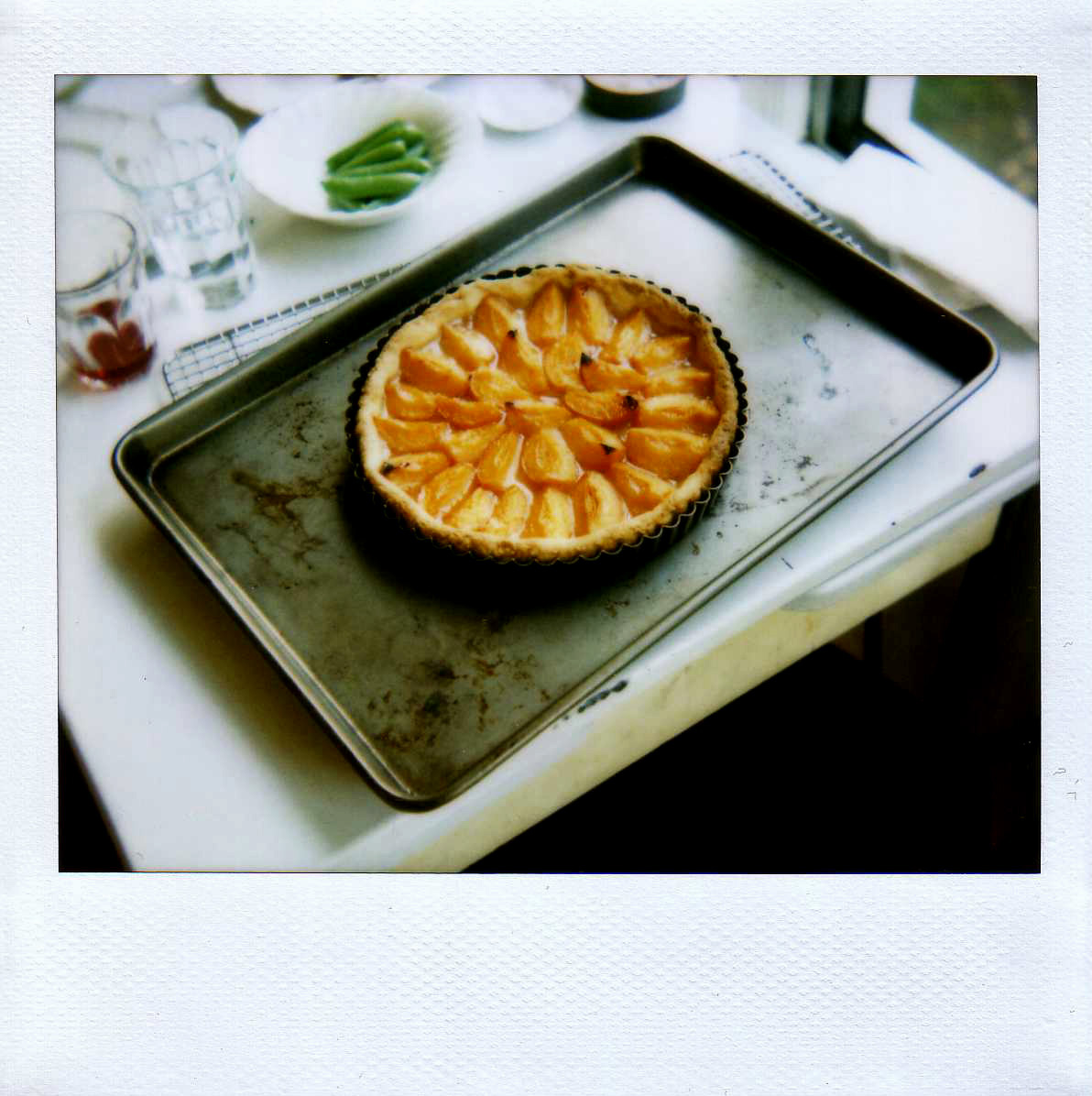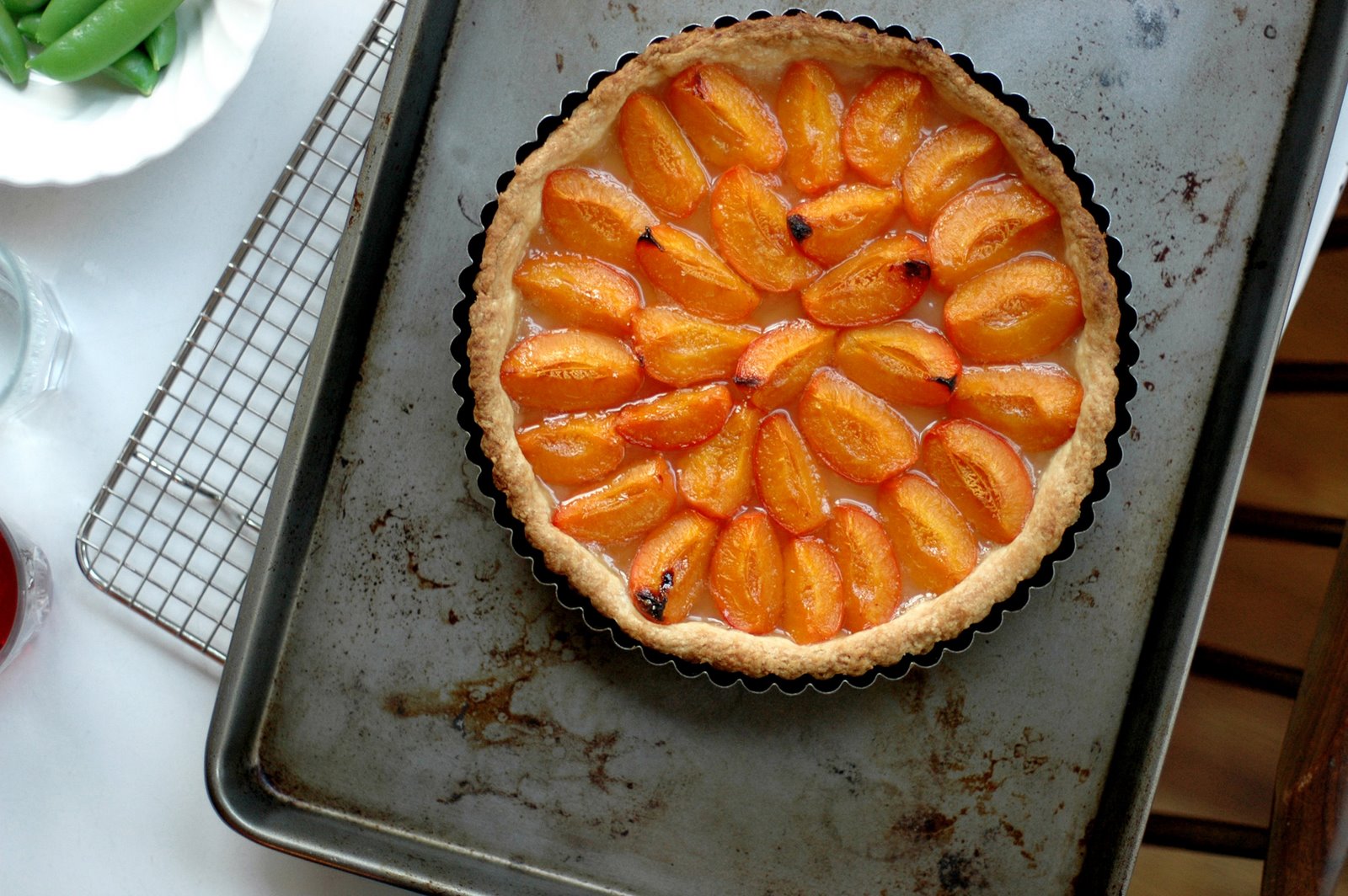The important parts
Hello again.
I sincerely hope that all our talk of chocolate chip cookies hasn’t left you in a sugar coma, because I come to you today with more sweets. Some of you are going to hate me for this, I know, but I had to. I didn’t have a choice. This past Saturday evening, a reader of this website sent me an e-mail with the subject line, “Looking for Good Pie Crust.” And get this: I happened to have an apricot tart sitting on my kitchen table at that very moment. I think this is what is sometimes called fate. Or happy coincidence. Or serendipity. Or synchronicity. Or all four.
Anyway, like I said, I didn’t have a choice. Also, I love apricot tarts.

I was introduced to this particular apricot tart a few summers ago. Actually, now that I think about it, it was three years ago this month. Brandon and I had met only a couple of months before, at the end of April. He was living in New York then, working part-time and going to graduate school, and I was in Seattle, working part-time and writing my Master’s thesis. That summer, we both chipped in toward a plane ticket, and he came to stay with me for five weeks. We hardly had any money, but my work schedule was flexible – a fact that almost, almost, made up for the lack of money – and we decided to drive to San Francisco for a week. We had family there to stay with, so we could do it on the cheap, and we could take the coast road, we decided, which was supposed to be gorgeous.
So we did. We threw our bags in the trunk and positioned a cooler of snacks on the back seat, and we drove. We ate tacos in the Mission and meringues at Tartine, Indian food in the East Bay and tomatoes on my aunt’s back deck. We also, as a splurge, had dinner one night at Zuni Café. I don’t remember many details of the meal, unfortunately, because I was very busy talking with my aunt during most of it – we two are talkers – and I was also quite intent on staring at the man across the table from me, this man who had amazing curls and who made my chest feel funny and tight and who, only three months before, I had not known existed. But I do remember one thing: the apricot tart. I always remember the important parts.
The Zuni apricot tart was a very simple affair. It was essentially a tart shell lined with sugared apricot halves and baked. There was no custard, no frangipane – nothing but apricot. If you look up the word “understatement,” I am pretty sure that, next to its definition, you will find an illustration of this tart. But it wasn’t the least bit boring. On the contrary, it was sweet and a little tangy, sticky at the corners and jammy in pockets, the fruit soft and the crust crumbly with butter. It was made with Royal Blenheim apricots, the menu gently boasted, and though they looked pretty average, their flavor was enormous: ripe, dense, almost rich. They tasted as though their essential apricotiness, or whatever you might call it, had been multiplied and concentrated by one of those fancy machines in Willy Wonka and the Chocolate Factory. In other words, this was a delicious tart.
So when I saw some especially nice apricots at the farmers’ market last week, I decided to try to replicate it. I had seen a recipe for an apricot tart in The Zuni Café Cookbook, and it looked as simple as I had imagined it would. Mine weren’t Royal Blenheims, of course, but maybe, I thought, if I played my cards right, they would surprise me.

And lo and behold, they did. Which is why I am yammering on and on about this. That, and because one of you wants a good pie crust, and the recipe I’m about to give you includes one.
I ordinarily hang on every word that Judy Rodgers writes, but in the case of this tart, I decided to forgo her crust recipe. Pie and tart doughs, I have noticed, tend to be a very personal matter for cooks: each of us has one that we love, and we tend to want to stand by it. I know I do. Until recently, I swore by Martha Stewart’s pie dough recipe. I made that stuff for years. But then my friend Olaiya introduced me to hers, and it was very, very persuasive. It’s an all-butter crust, like Martha’s, but it differs a bit in the amounts, and it also includes a smidgen of apple cider vinegar, which helps to relax the gluten in the flour and keep the dough tender. Also, it just seems to work more easily, and more consistently, than Martha’s does. I am in love. (Sorry, Martha. We can still be friends!)
I’ve made this pie dough recipe a dozen times now, easy, and it is the one that I am using in my book, and I really can’t say enough good things about it. It’s buttery and impossibly flaky and has yet to let me down, and on several occasions, it has even inspired perfectly sated people to beg for seconds. I don’t know about you, but that’s what I look for in a pie dough. Top it with some ripe, fragrant apricots, a little sugar, and a bit of salt, and you’re in business, as they say. In the heat of the oven, the dough goes golden, crisp, and toasty, and the apricots release their juices to mingle with the sugar, forming a glossy, sweet-tart glaze that settles under and around them. Cut into wedges and dolloped with crème fraîche, it’s the closest you can get to serving summer on a dessert plate. And when you run out of chocolate chip cookies, that’s not a bad idea.
Apricot Tart
Adapted from The Zuni Café Cookbook
Because this preparation is so simple, be sure to choose the very best apricots you can find. If you can, ask to taste them before you buy. There is little in this recipe to disguise their flaws, so if they are mealy, watery, tart, or otherwise lacking, this is not the best use for them.
This tart would also be delicious with Italian or French prune plums, those small, oblong, purple-skinned plums that come into season in late August and September. For those, you can use a little less sugar – about ¼ cup, rather than 1/3 cup.
For crust:
4 Tbsp. ice water, plus more as needed
¾ tsp. apple cider vinegar
1 ½ cups unbleached all-purpose flour
1 Tbsp. sugar
¾ tsp. salt
9 Tbsp. (4 ½ oz.) cold unsalted butter, cut into cubes
For filling:
About 1 lb. small, fragrant, firm-ripe apricots
Heaping 1/3 cup sugar
3 pinches of salt
To prepare the crust:
In a small bowl or measuring cup, combine 4 Tbsp. ice water and the cider vinegar.
In the bowl of a food processor, combine the flour, sugar, and salt. Pulse to blend. Add the butter, and pulse until the mixture resembles a coarse meal; there should be no pieces of butter bigger than a large pea. With the motor running, slowly add the water-vinegar mixture, processing just until moist clumps form. If you pick up a handful of the dough and squeeze it in your fist, it should hold together. If the dough seems a bit dry, add more ice water by the teaspoon, pulsing to incorporate. I sometimes find that 1 additional teaspoon is perfect.
Turn the dough out onto a wooden board or clean countertop, and gather it, massaging and pressing, until it just holds together. Shape it into a ball, and press it into a disk about 1 ½ inches thick. If the disk cracks a bit at the edges, don’t worry; just pinch the cracks together as well as you can. Wrap the dough in plastic wrap, and then press it a bit more, massaging away any cracks around the edges, allowing the constraint of the plastic wrap to help you form it into a smooth disk. Refrigerate the wrapped dough for at least 2 hours. (Dough can be kept in the refrigerator for up to 4 days or frozen for up to 1 month. Thaw it in refrigerator overnight before using.) Before rolling it out, allow the dough to soften slightly at room temperature.
To assemble:
Set an oven rack to the middle position, and preheat the oven to 375°F.
On a lightly floured surface, roll the dough into a circle wide enough to fit a 9-inch removable-bottom tart pan. Transfer the dough gently into pan, and ease it into the corners and up the sides. Trim the edges to extend about ½ inch beyond the pan; then fold the overhang inward and press it against the side of the pan to reinforce the edge. Put the tart shell into the freezer while you prepare the fruit.
Cut the apricots in half, remove the pits, and then cut each half in half again. (In other words, the apricots should be quartered.) Put them in a wide bowl, and toss them gently with the sugar and salt. It might look like a lot of sugar, but don’t worry; it is balanced nicely by the salt and the acidity of the fruit. Remove the tart shell from the freezer and quickly arrange the fruit inside it, cut side up, in concentric circles. Scrape any sugar remaining in the bowl over the fruit.
Bake the tart until the crust is golden brown and the fruit is soft and relaxed, about 45 minutes or longer. It’s alright if some of the pieces of fruit are a little burnt (or, I suppose, caramelized) at their edges or tips. The sugar and juices from the fruit should form a loose glaze of sorts in the bottom of the shell and around the fruit, and as the tart cools, the glaze should thicken slightly.
Serve with crème fraîche or whipped cream.
Yield: 6 to 8 servings
Note: The crust portion of this recipe can easily be doubled to make a (double-crust) pie.

